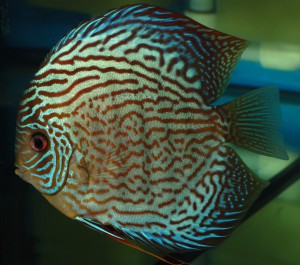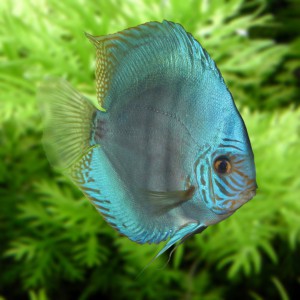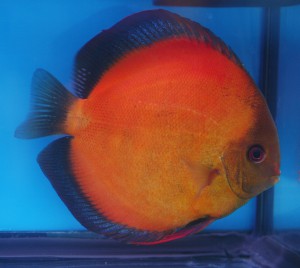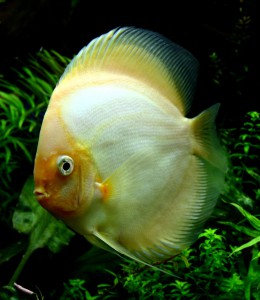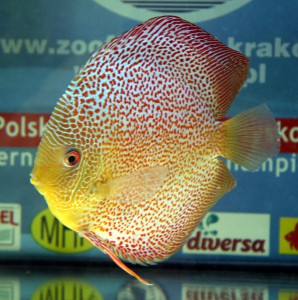The emerging new color forms of breeding discus fish made it impossible to maintain the current standardization. As usual, life was ahead of any codifications created. The general assumption of the assumed changes that the judges in various countries in the world worked on was the maximum simplification of standards. This is not an easy task considering that the introduced changes should take into account all existing color forms of discus fish, as well as become more understandable for every Symphysodon fish lover.
In Poland, in the years of 2012/2013, the Judges Council of the Polish Club of Discus Lovers was working intensively on this issue.
In the light of these events, the International Conference in Warsaw took on special significance, in which representatives of the most active Clubs dealing with the subject of fish care from the Symphysodon genus took part.
As I mentioned, life and related problems, and in particular changes occurring in the environment are always ahead of any codifications created. Therefore, there was a need to introduce further changes in discus fish standardization.
During the meeting of the members of the PKMD during the presentation of fish at the Lublin ZOOPARK – 2019 exhibition, which took place in March, it was decided, that from this year discus fish from natural environment (wild caught discus) will cease to be evaluated at the Discus Fish Championships. This position was adopted by the Management Board of PKMD in the form of a Resolution.
This decision caused, that the wild caught discus fish class and the color groups evaluated in it were removed from discus standardization:
„A”. Heckel.
„B”. Brown.
„C”. Blue.
„D”. Green.
Fish collected from natural environment (wild discus) will not be accepted for contests organized in Poland, and if they are entered, they will not be judged.
Only discus fish from cultivated (breeding) groups will be evaluated by the judge.
THE NEW STANDARDIZATION OF DISCUS FISH will apply from 2019 on the International Discus Championship and the Polish Discus Championship.
Category of breeding discus.
It consists of 8 color groups to which all colored groups known from the previous division will be included, as well as some colored forms, which, due to the preservation of genetic traits in their representatives, should already be treated similarly. The Judges Council of the Polish Club of Discus Lovers took the position that it was necessary to withdraw the Albino group from the division into competition color groups. This position is supported by the fact, that albinotic fish are present in all color groups and creating a separate group in this situation is pointless. Discus fish characterized by albinism should be displayed in all separate colored groups, and this attribute should not only affect the reduction of the score when judging the eye of the fish.
„E” Turquoise with a pattern (Striped turquoise).
In this group, two previously separate color groups were combined. Thus, it will be used to evaluate both traditionally lined discus, formerly a group of Striped turquoise, and discus with a thick red pattern, ie the former Red turquoise group. This will eliminate the relatively frequent mistakes that have occurred so far in the course of entering by aquarists such discus fish for the competition. In the case of these fish, it will be particularly important that longitudinal lines of both straight and slightly wavy shape cover the entire sides of the body, and the dorsal and anal fin, and forehead. The lack of a full pattern on the body will be considered a mistake. The basic body colors, constituting the background for the pattern, are: turquoise-blue, turquoise-red and turquoise-brown. The lines forming the pattern should have a red color and may have different shades. The iris around black pupil in the eye should be red. It is acceptable to display albinotic fish in this group, in which the pupil has a red color. Discus presenting short, dashed lines will be evaluated in group „I” – Fine Patterned.
„F”. Turquoise-blue (Solid Turquoise Discus).
In this group discus with a blue turquoise or bluish basic body color, slightly opalescent be will assessed. The degree of intensity of blue and turquoise hue will not matter. This group will include discus, which present not too much turquoise pattern on the sides, forehead, as well as the anal and dorsal fins. Discus with a uniform blue or bluish color, without any pattern on the body and fins will be assessed in the group „H” – Solid Discus. It is important that the assessed fish have black pupils and a red iris of the eye. It is acceptable to display albinotic fish in this group, in which the pupil has a red color.
„G”. Solid red (Solid Red Discus).
In this group discus with a uniform red body color, as well as red discus having black underlining on the dorsal, anal and caudal fin will be assessed. The disputable issue was, whether to include in this colored group two-colored forms, eg Red melon and Red White. The Judges Council of the Polish Club of Discus Lovers’ is of the opinion that so colored discus should be classified in this group, provided that no pattern appears on their body, apart from the two basic colors mentioned. It is important that all fish rated here have black pupils and a red, pink or orange iris. It is acceptable to display albinotic fish in this group, in which the pupil has a red color.
„H”. Solid color (Solid Discus).
In this group discus with a uniform body color, other than the red one will be assessed. As a result, discus with blue, yellow and white color will be here. The essential condition is that, there should be no pattern on their body and fins. However, darker underlining on the dorsal and anal fins are acceptable. It is important that all fish rated here have black pupils and a red, pink or orange iris. It is acceptable to display albinotic fish in this group, in which the pupil has a red color.
„I” Fine Patterned.
This group will include, among others, all discs from the two previously separately graded color groups. These will be fish classified in the Snake skin group and some forms of Pigeon blood, provided that the pattern on their body will be fine. In addition, other colored discus forms will be evaluated, which have all kinds of short linear patterns on the body, regardless of the basic body color, except for those that will be classified in the groups: „E”, „J” and „L”. It is acceptable to display albinotic fish in this group, in which the pupil has a red color.
„J” Coarse Patterned.
This group will include, among others, all discus presenting a thick, linear pattern. Most often they will be fish classified so far in the Pigeon blood group, as well as those, in which the pattern are large dots or spots, e.g. the „Ring” color form, not meeting the requirements within the dotted group – Spotted. In addition, other colored discus forms will be evaluated, which have on the body all kinds of thick, sometimes short, linear patterns, regardless of the basic body color, except for those that will be classified in groups: „E”, „I” and „L” „. It is acceptable to display albinotic fish in this group, in which the pupil has a red color.
„K” Spotted.
In this group there will be all discuss, regardless of the basic color of the body, presenting on the body a pattern consisting of small dots. Their diameter can not exceed 2 mm, because then they will be assessed in the group „J”. Small dots should be regular and not mixed with short lines, because then you should also evaluate the fish in group „I”. Preference will have discus which will have described pattern throughout the body. Dots coming in contact with each other in this case is a disadvantage. The group in question in this case, is an exception, since it is assumed that discus should be assessed together, regardless of the basic color of the body. It is also important that all fish rated here have black pupils and a red, pink or orange iris. It is acceptable to display albinotic fish in this group, in which the pupil has a red color.
„L” Not classified (Unclassified).
In this case, only the name of this color group has changed. The former name „Open class” color group has been changed to „unclassified” – Unclassified. The judges codifying this color group in Naples came to the right conclusion that this name more reflects the character of the group in question, because it will evaluate all those discus whose specificity and appearance does not allow them to be placed in the above-described seven groups of breeding discus fish with the requirements of any known color group. It will include all the fish presenting undiscussed designs, different from the established colors, unique combinations of colors, unique patterns, as well as those that have elongated fins. In the future, if an authentic color group is crystallized from this type of fish, it can be separated if necessary into a separate evaluation. It is permissible to exhibit albinotic fish in this group, in which the pupil has a red coloring, and the other presented features do not allow their assessment in seven previously arranged color groups.
PBC – Polish White – Red.
The fish group with white and red coloration, which take part in the Andrzej Ogrodnik Memorial, is a separately assessed group of discus fish. These are usually fish rated in the basic color group „G, which are characterized by a white head and a red body. This coloration is reminiscent of the national colors of our country. In practice, such colored fish are evaluated twice in the competition – once in the „G” group, and then in the PBC group. The PBC Group does not appear at contests in other countries and is a specific form of commemoration of the creator of the „TROPICAL” company – a significant aquarist who significantly contributed to the development of aquaristics in Poland.
Evaluation card
At present, there are no uniform international arrangements as to the rules for assessing discus fish at contests. The Judges Council of the Polish Club of Discus Lovers proposes that the method that has been in force in Poland since 2006, ie the organization of the International Discus Championships by PKMD, has been generally accepted. This is evidenced by the fact that this system has proven itself in practice and has been met by many European and Asian judges. During the interviews, most of them admitted that this solution is clear and easily understandable for all evaluators. Noteworthy is the fact that the system for assessing other species of fish at international and national competitions (Xiphophorus, Poecilia) was based on the 10 x 10 model, ie 10 thematic issues already in the 1980s, and for each of them the judge could maximum to grant 10 points. According to the proposed idea, the judges’ card may in this case include the following issues:
- Body size – max. 10 points;
- Proportions and harmony of the body – max. 10 points;
- Dorsal fin, anal – max. 10 points;
- Tail fin – max. 10 points;
- Fins and abdominal fins – max. 10 points;
- Gills – max. 10 points;
- Eyes – max. 10 points;
- Pattern on the body – max. 10 points;
- Colors – max. 10 points;
- General appearance – max. 10 points;
Total – max. 100 points
PKMD proposes that the basic condition that should be met by each organizer was that the evaluation should make at least 6 judges, and the sum of points awarded by them after rejection of the highest and lowest marks was divided by the number of discerning specialists. The obtained average will be the final result.
Evaluation rules.
- Body size
From many descriptions of the color groups, it appears, that while species occurring in the natural environment have in many cases the possibility of reaching sizes up to 20 centimeters, then it does not reach such a large size in breeding colored forms in a given color variety. This phenomenon becomes particularly noticeable in breeding fish that are representatives of colored forms: Red, Red Spotted or Snake Skin. This remark can not be used for discussing discus fish from the „Pigeon Blood Discus” color group, whose representatives are often exceeding in size. Similar phenomenon can also be found in other natural and breeding groups.
While analyzing the results from individual discus fish competitions, one can get the impression, that the majority of judges particularly prefer and reward fish of the largest size. Of course, this is the case when there are no obvious defects in classified discus in all other items that are assessed. Such a position is dictated by the desire to eliminate specimens with a tendency to be stunted, because nowadays, it is an increasingly common defect. The above view, misunderstood, may also result in some danger. Aiming to obtain the largest size by the fish, the proportions of other assessed elements may be disturbed. It is true that the large fish proved to be always more decorative, but more important in this case are properly maintained proportions.
- Proportions and harmony of the body.
According to specialists, the proportions and harmony of the body are elements that are very important and significantly affect other fish characteristics. The generic name of the fish in question clearly suggests how a discus fish should look like. Looking at the fish from the side, her body should be put in a circle. It is worth noting that when we say „body”, most often in the case of discus fish, it is the head and trunk of the fish, while omitting its fins. Regardless of the view expressed in this matter, if the fins are also included in the body, only the posterior part of the caudal fin can be found outside the circle.
A strong lateral flattening of the body is another element affecting the shape of the fish. This does not mean, however, that fish should be as thin as the proverbial razor. Flattening the body can not justify thinness. The discus should be well muscled, and the skeletal components can not be seen through the skin. The body of the fish should in principle resemble the circle as much as possible. Absolutely beware of these fish, in which the body is found to form a horizontally arranged ellipse. This is a very serious disadvantage.
- Dorsal and anal fin.
Fins are another very important element of the assessment, because they significantly affect the entire appearance of the fish. For the purposes of this point of assessment, the judge should assess the overall appearance of the dorsal and anal fins. Any defects, stains, endburns, turbidity and cracks appearing on them reduce the possible scoring. It is assumed that the first hard ray of the dorsal fin should be at the level of the ventral or pelvic fin. The line between these points should be perfectly vertical. Just behind the above mentioned abdominal fins, which should be characterized by a significant length and have a distinct crescent-like bend, the first hard ray of the anal fin should begin (anal fin). Both in anal and dorsal fins, hard rays should be expressive and well marked. The soft-rays parts in these fins should be wide and shaped in a line forming a gentle arch. Depending on the variety, the upper part of the dorsal fin and caudal fin, should end with a delicate arch or create a slightly marked spike.
When assessing all the fins mentioned here, the judge only judges their shape. The color is not assessed, as well as the pattern appearing on them, because this issue is assessed as a whole in point 7 and 8. Otherwise, if any defects were found, the judge would assign two penalty points for the same element twice.

Now, however, in the assessment, any breaks that can sometimes be observed on the outer periphery of the dorsal and anal fins should be taken as negative. I realize that the presented description is at first glance a bit complicated, but reading and comparing it with the discus swimming in the tank, every aquarist will quickly understand what this is all about.
- Tail fin
Separating the caudal fin as a separate element of the assessment seems to be right. It is recommended, that the final part of the base of the dorsal and anal fin together with the beginning of the base of the caudal fin create a vertical line. The caudal or tail fin, its shape should resemble a partially open fan, and its ending should form a gentle semicircle emphasizing the circular shape of the fish. All rays in the tail fin should be well marked, straight and proportionally distributed.
Defects, stains, as well as overburning of the final part, turbidity, tarnishing, discoloration and cracks occurring in it absolutely reduce the possible scoring.
In a number of color forms, the tail fin should be completely transparent, in others black or „smoked” which is worth remembering now, although this feature is not evaluated here.
- Pectoral and abdominal fins.
Any defects, stains, overburning of tips, turbidity and cracks occurring on them, necessarily reduce the possible scoring. Hard rays should be expressive and well marked. The soft-rays parts in these fins should be wide and well-shaped. Depending on the variety, the fins should be transparent, or have the right shade for the given form, e.g. black.
The ventral fins should be of equal length and well formed.
- Gills.
Gill covers should be proportional to the size of the head and the entire body. A very big disadvantage is visible gill laminae, which often go beyond the perimeter of the covers. It is true that the color and the pattern on them are not evaluated here, because they refer to point 7 and 8 of the evaluation card, it is worth remembering that depending on the color group to which the fish was included, the drawing (pattern) should be present on the gill covers, or vice versa, they should have a uniform color. A visible metallic glow is desirable.
- Eyes.
The vision organ is well developed in discus fish. The eyes are so positioned that the field of view of each of them partially overlaps. So we can say that in this case we are dealing with the phenomenon of binocularity. In the discus fish, this feature is further intensified by the ability to move the eyeballs to a small extent. Discusses have the ability to see a large field of view, which means that they can see a significant part of their surroundings without moving. The lens should have a spherical shape and the healthy one is hard, which means that it has no ability to change shape. In the case of discus fish, eyes are an element that by its clarity often attracts the viewer’s attention. Generally speaking, we see in the center of the eye a relatively large and distinctive black spot, which is surrounded by a ring. This ring, depending on the color form viewed, may have different shades of red color, and in several forms it is characterized by orange or yellowish color. Such coloring can be observed in some forms of the colorful „Pigeon Blood Discus” variety. Eyes should not stand out from the head and such their arrangement means a fish’s well-being. The proportion of the eye size to the fish’s body is also important, excessively large, is a disadvantage. An experienced aquarist observing the eyes of a fish, can give a lot of valuable information about the general health of the specimen.
In the case of albinotic discus, the pupil in the eye should be red and this is not a disadvantage.
- Pattern on the body
In many forms of colorful discus fish, which are grouped in a given color group, the pattern that covers the body or its absence determines the attractiveness of the fish. While the definition of basic colors is basically no problem, it is usually much harder to describe patterns found on discus fish. There are also cases that without photographic material it turns out to be completely impossible. Can anyone describe faithfully with words Wattley’s Panda colorful form?
Generally, it can be assumed that the pattern appearing on the discus body is determinant of belonging to a given color form. It can be made of various thicknesses and lengths of lines, often undulating, dots, stains etc. The expressiveness of the pattern depends on the color form to which discus belong. In a number of cases, it can be contrasting and flashy, but it can also be delicate and as if damped by the basic color.
In the case of colored forms of the Solid type, the occurrence of any design is a disadvantage, and the judge rewards in this situation its absence.
- Coloring
Vivid and decisive basic colors can only be observed in healthy and well-feeling fish that do not know what the stress is. Generally it will not be a mistake to say, that the fish should „shine”. This remark is particularly justified in the case of smooth colored forms, such as the Solid Turquoise color form, where the primary color is the only color that occurs, which in principle determines the attractiveness of the fish. In the case of discus fish breeding forms, we now have a relatively wide range of basic shades of color.
A completely separate issue in this case is the grading of the assessed fish, presenting the given color scheme to individual color groups. Subdued and matt colors or the disappearance of basic colors by general darkening of the body is characterized by sick fish. It is hardly surprising, therefore, that the judges evaluating the fish pay very much attention to this immensely important element.
- General appearance
Each aquarist most often feels intuitively, which of the fish’s he watches has the right proportions, shapes and colors. In other words, the issue comes down to the task of asking yourself: „would I like to host such a discus in my aquarium or not”. In this simplest way you can define the concept – general appearance.
It is worth remembering that the judge’s assessment is always somewhat subjective. This phenomenon can be especially observed in all areas of non-measurable sports or singing competitions, where this kind of mechanism plays a very large role, occasionally evoking conflicting feelings. It is true that the judges usually bind generally applicable directives, which have been established within a certain standard, but always have to take into account the fact that he has the right to individuality of perspective.







